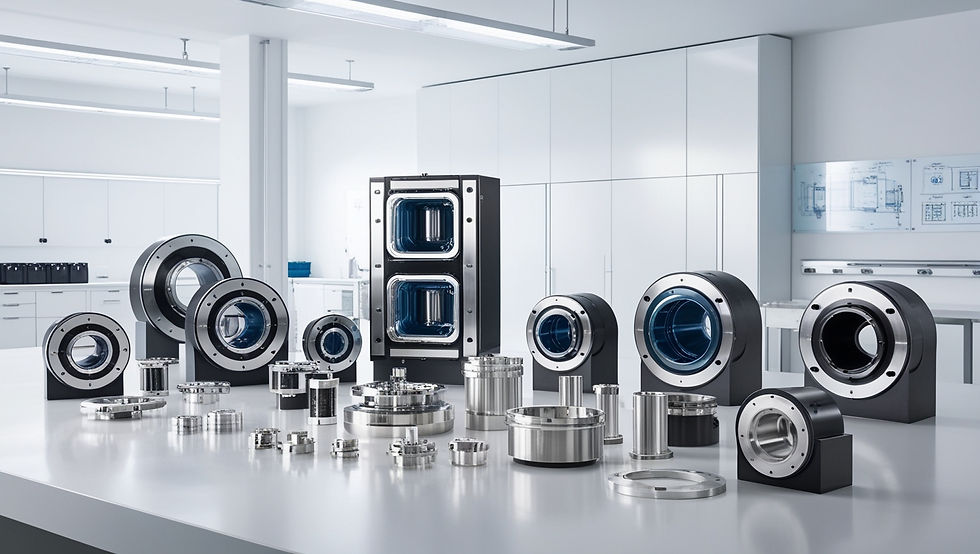Different Types of Vacuum Chamber Parts in the Semiconductor Industry
- synergypepg
- Apr 8
- 4 min read
The semiconductor industry relies heavily on precision engineering and ultra-clean environments. One of the most critical components in the fabrication process is the vacuum chamber. These chambers create a controlled environment, free from air and other contaminants, where silicon wafers are processed into the microchips that power everything from smartphones to satellites.
But a vacuum chamber isn’t just a single piece of hardware—it’s a complex assembly of parts, each playing a unique role in maintaining stability, cleanliness, and efficiency. In this guide, we’ll walk you through the different types of vacuum chamber parts used in the semiconductor industry, their roles, and why they matter.
1. Chamber Body
At the heart of any vacuum system lies the chamber body. This is the physical structure where semiconductor processes take place, such as etching, deposition, or ion implantation.
Typically made from stainless steel or aluminum
Must be leak-tight, chemically resistant, and capable of withstanding pressure differences
Precision-welded or machined to minimize contamination and maximize durability
2. Viewports and Observation Windows
Viewports allow operators or optical systems to monitor the interior of the vacuum chamber without opening it. These are usually made from:
Quartz or sapphire glass for high optical clarity
Coated with anti-reflective layers to minimize light distortion
Mounted with vacuum-compatible seals to prevent leaks
3. Vacuum Pumps and Flanges
To maintain a low-pressure environment, the system depends on a series of vacuum pumps connected through flanges and other connectors.
Turbo-molecular pumps, scroll pumps, or cryogenic pumps are commonly used
ISO, CF, and KF flanges are used to connect the chamber to the pumps
Flanges are sealed with O-rings or copper gaskets depending on the system
4. O-Rings and Seals
Small but mighty, O-rings and seals ensure that there are no air leaks in the system.
Usually made from Viton®, Buna-N, or perfluoroelastomer
Placed between flanges, around doors, or near observation windows
Regular inspection and replacement are necessary to maintain vacuum integrity
5. Baffles and Shielding Plates
These components serve two key purposes: protecting internal surfaces from deposition and reducing contamination.
Positioned inside the chamber
Act as barriers that redirect particles or gases
Help extend the lifespan of internal parts and reduce downtime
6. Feedthroughs
Feedthroughs are interfaces that allow electrical, optical, or gas connections to pass through the chamber wall without compromising vacuum integrity.
Electrical feedthroughs for powering internal components
Gas feedthroughs for introducing controlled gases into the chamber
Thermocouple feedthroughs for temperature monitoring
7. Internal Fixtures and Wafer Holders
Inside the chamber, components such as wafer holders, susceptors, and robotic arms are used to support and manipulate wafers.
Made from ceramic, quartz, or high-grade stainless steel
Must withstand high temperatures and chemical exposure
Designed for precise positioning and minimal contamination
8. Cooling and Heating Systems
Temperature control is critical during many semiconductor processes.
Chambers often include water-cooled jackets or electrical heating elements
Thermal control systems ensure consistent wafer processing
Helps maintain the right conditions for plasma generation, chemical reactions, or material deposition
9. Pressure Gauges and Sensors
You can’t manage what you can’t measure. That’s why vacuum pressure gauges and sensors are vital.
Used to monitor pressure inside the chamber in real-time
Common types include ion gauges, Pirani gauges, and capacitance manometers
Data is used to adjust pumps and valves for precise control
10. Valves and Flow Controllers
To ensure stable operation, valves and flow controllers regulate the entry and exit of gases and isolate parts of the system.
Butterfly valves, gate valves, and angle valves are common
Some are manually controlled, while others are electronically actuated
Help maintain consistent process environments
11. Load Locks and Transfer Chambers
For high-throughput semiconductor production, load lock systems are integrated to move wafers in and out of vacuum environments without venting the entire chamber.
Prevents atmospheric exposure
Ensures continuous operation
Paired with robotic arms or vacuum-compatible conveyors
12. Getters and Traps
These are components used to capture residual gases or contaminants within the chamber.
Sorption pumps and getter materials chemically bind with stray particles
Cold traps use low temperatures to condense out unwanted vapors
Enhance the vacuum quality and prevent process interference
Why These Components Matter in Semiconductor Manufacturing
Every single part in a vacuum chamber is engineered for precision. In semiconductor production, even a microscopic contaminant or a minor pressure fluctuation can ruin an entire batch of wafers. That’s why:
High-quality materials are non-negotiable
Seamless integration between parts ensures stability
Regular maintenance is crucial for performance and safety
By understanding and optimizing each part of your vacuum chamber, you not only improve product yield but also extend the life of your equipment.
Conclusion:
The semiconductor industry doesn’t leave room for error. Whether you're running an R&D lab or a high-volume fab, the efficiency of your vacuum chamber directly affects your bottom line. From O-rings to wafer holders, every component has a role to play in creating a clean, stable environment where the magic of microelectronics happens.
Choosing the right vacuum chamber parts—and maintaining them properly—can mean the difference between consistent success and costly downtime. So if you're aiming for top-tier performance and unbeatable precision, it’s time to start paying attention to the parts that make it all possible.
Get more information about vacuum chamber parts through the following blog





Comments